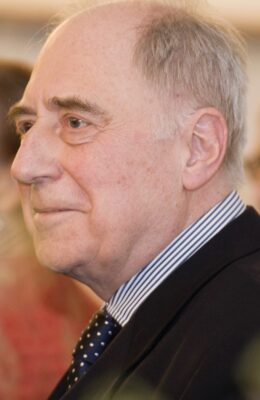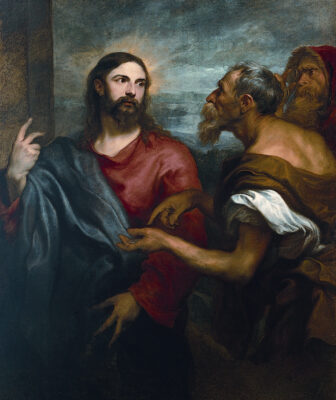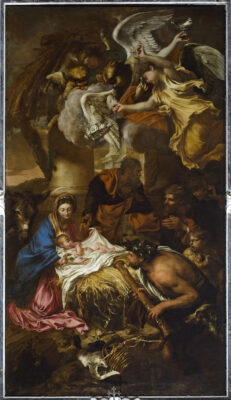 A productive scholar until his death on January 3rd, 2025, Rudolf Preimesberger, professor emeritus at the Freie Universität Berlin, will be remembered as a scholar of rare imagination and erudition, and will be sorely missed as a colleague and friend who not only generously shared his own insights, but also remained curious about newer approaches to the history of art. Best known as an eminent expert on Italian Baroque art, his fewer and, I believe, lesser-known writings on Netherlandish art, which are the focus of this all-too-brief tribute, reveal the highly original scope of his approach, which, always guided by the artwork’s visual language, explored the world of thought to which its creator belonged, demonstrating the intricate relationship between artists’ practices and ideas, painterly sophistication and conceptual complexity. He was interested in exploring how painters who had been formed in different artistic, linguistic, and cultural environments asserted their knowledge and skills in exchange and competition with the dominant (Italian) language of art. While he was always very clear about the questions posed by a work of art, he was at the same time a committed advocate of the multiplicity of (often contradictory) meanings and affects it produced, of the way it superimposed aesthetic and religious codes, referenced classical or local antiquity, and engaged with current artistic debates.
A productive scholar until his death on January 3rd, 2025, Rudolf Preimesberger, professor emeritus at the Freie Universität Berlin, will be remembered as a scholar of rare imagination and erudition, and will be sorely missed as a colleague and friend who not only generously shared his own insights, but also remained curious about newer approaches to the history of art. Best known as an eminent expert on Italian Baroque art, his fewer and, I believe, lesser-known writings on Netherlandish art, which are the focus of this all-too-brief tribute, reveal the highly original scope of his approach, which, always guided by the artwork’s visual language, explored the world of thought to which its creator belonged, demonstrating the intricate relationship between artists’ practices and ideas, painterly sophistication and conceptual complexity. He was interested in exploring how painters who had been formed in different artistic, linguistic, and cultural environments asserted their knowledge and skills in exchange and competition with the dominant (Italian) language of art. While he was always very clear about the questions posed by a work of art, he was at the same time a committed advocate of the multiplicity of (often contradictory) meanings and affects it produced, of the way it superimposed aesthetic and religious codes, referenced classical or local antiquity, and engaged with current artistic debates.
Trained in the Vienna school of art history, his decision to make Berlin his home allowed him to critically reflect on and expand this tradition. Fifteenth-century Netherlandish art was certainly a familiar field for Preimesberger, who had also studied with Otto Pächt before leaving for Rome. But it was only in his years as professor and chair of art history at the University of Zurich (1983–1989) that he turned or, rather, re-turned his attention to fifteenth-century Northern European art, the formative principles of which Pächt had so fruitfully explored both during the long years of his exile in England (1936–1963) and during his late professorship in Vienna. By this time, Preimesberger had long made a name for himself as an expert on Italian art; he had spent many years in Rome, served as the second director of the Zentralinstitut in Munich (1972–1979), accepted a professorship at the Freie Universität in Berlin (1979–1983), and become a member of the Institute for Advanced Studies in Princeton (spring 1981). His interest in the way the “new” kind of painting was asserting itself on the European artistic map in the fifteenth century was sparked by one of the most exquisite works of the period, Jan van Eyck’s Annunciation Diptych, now in the Thyssen-Bornemisza Collection, then still at the Villa Favorita in Lugano, which soon became his favorite Swiss museum. Those of us lucky enough to be his students then enjoyed attending the seminars he held in the beautiful seventeenth-century villa on days when it was closed to the public. Preimesberger approached Van Eyck’s masterpiece of a trompe-l’oeil depiction of a white sculpture, faintly but precisely reflected in black stone, from an entirely new angle, seeing in it an early instance of Van Eyck’s assertive dialogue with sculpture, including its most prominent contemporary example, the Champmol tombs for the Burgundian dukes Philip the Bold and John the Fearless. The astonishingly lifelike figures of the mourners on those tombs, carved in white marble and forming a procession around the slab of black Dinant marble, were now superseded by Van Eyck’s own art, with its equal claims to realism, presence, and affective impact.
It was during his membership at the IAS that Preimesberger began to explore the rival claims of greater virtue among painters and sculptors, a rivalry, he repeatedly insisted, that was often inspired and driven by mutual esteem, social aspirations and the desire for recognition of the ambition of each one’s own art. In Van Eyck’s case, it was above all through his rendering of reflections that he entered into a “duel” with the sculptor, an artifice made possible by the much-admired luminosity of the “new” oil-based medium, and which also allowed the artist to expand the pictorial space to include figures outside it, such as that of the artist as the creator of the painting, thereby taking revenge for the low status generally ascribed to the pictorial arts.

Preimesberger’s visual acuity and literary knowledge also plays a central role in his perceptive analysis of Anthony van Dyck’s painting of The Tribute Money, now in the Palazzo Bianco, Genoa, and generally believed to have been made during the artist’s stay in that city between 1621 and 1627 (Fig. 1). His essay may be taken here as an example of his deep interest in artistic invenzione and what he called “figures of art” (“Kunstfiguren”), iconographic novelties, at the same time enigmatic and appealing, in which the visual and the cognitive converge. In Van Dyck’s The Tribute Money, it is the anonymous figure in the background who, through the convex lens held in front of his right eye, captures the (magnified) profile portrait of the son of God. Of exactly the same size as the tribute money in the hand of Christ’s interlocutor, the lens reveals the identity of its myopic bearer as Lentulus, the fictitious author of a letter to emperor Tiberius describing the perfect countenance of the powerful Nazarene, and, being transparent, evokes the emerald cameo made at the behest of the same emperor and supposedly showing Christ’s face in profile (as the emperor’s likeness appeared on the coin). As such, the surprising attribute also responded to specifically painterly concerns, the tensions between image, resemblance, and likeness, and, ultimately, between reality and representation.

In Rembrandt’s Judas Returning the Thirty Pieces of Silver (1629), it is Judas’s gesture, expressing repentance and utterdespair, that must have commanded the attention of an audience well versed in the theology of predestination and thus torn between the affects of compassion and revulsion. In Caravaggio’s Entombment (1603–1604) for the Chiesa Nova in Rome, it is the striking figure of the hunchbacked Nicodemus with Michelangelo’s features, that served the ambitious painter (who shared his first name with Michelangelo) to draw attention to his ability to bend, arch, or “hunch” his paintings, to make them seem to protrude into real space; as Preimesberger noted, Peter Paul Rubens, who executed the high altarpiece for the same church, perfectly understood Caravaggio’s identification of the first sculptor of the Christian era with the foremost sculptor of the previous century, but chose to remove the physical deformity his Italian colleague had given him. In Giovanni Benedetto Castiglione’s Adoration of the Shepherds made in 1645 for San Luca, the private church of the Spinola and Grimaldi families, it is the laurel-crowned, faun-like shepherd playing the dulciana (or fagotto), a new wooden wind instrument named for its soft and sweet sound, that would have caught the eye of a contemporaneous viewer (Fig. 2). Lending sound to a mute painting and superimposing elements of Virgilian bucolic poetry on Christian pastoral imagery, the faun also marks a temporal rupture between an imagined antiquity and the performative and liturgical present. Flemish genre motifs echo throughout the painting. In El Greco’s Assumption of the Virgin of 1577, painted for the high altar of Santo Domingo el Antiguo in Toledo (now in the Art Institute, Chicago), it is the cartellino with the artist’s signature in Greek that seems to leap out of the pictorial space, signaling to the learned viewer that the painter, by his representation of a religious mystery, is continuing a long tradition going back to Homer and Phidias who had shown the “icons of the gods.”
Not surprisingly, Genoa was among the places to which Preimesberger felt a close connection, the ancient port republic that emerged as one of Europe’s leading financial centers at the turn of the seventeenth century, with the presence of Flemish and German artists and merchants, and its long tradition of sculpture in wood, which he studied for his doctoral dissertation on Genoese Baroque sculpture. In his essay on Castiglione’s Adoration of the Shepherds the spatial layout, history, and recent development of Genoa is told through the eyes of a fictitious northern visitor (perhaps a Protestant or a Libertine?) who arrives in the city by sea at the end of January 1646 and then makes his way through the bustling center to San Luca. Those of us who had the pleasure of participating in one of Preimesberger’s study trips to Genoa will remember the way he introduced us to the peculiar spatial layout of the city, leading us through the old commercial center, with its tall buildings and narrow streets, to the Strada Nova with its luxurious palaces, part of the modernization and expansion of the city in the sixteenth century, which Peter Paul Rubens drew during his stays in the city and later published with the explicit aim of improving the architecture of his own hometown.
Rather than to normative iconography, Preimesberger was drawn to the breaks and ruptures that signaled early modern artists’ reflections on the virtues and values of their own works. Deeply committed to research as an ongoing process of inquiry, his extraordinary knowledge and learning also made him aware of, and open to, the conjectural and controversial aspects of the discipline. As a result, he was not only an outstanding scholar but also a compelling, highly respected, and beloved teacher, one who was not interested in creating a school, but rather in facilitating a dialogue across generations and changing fields of interest and expertise.
Christine Göttler
University of Bern
Works Cited:
The chapters “On Jan van Eyck’s Diptych in the Thyssen-Bornemisza Collection” and “Pittura Gobba: Conjectures on Caravaggio’s Entombment” are published in Rudolf Preimesberger, Paragons and Paragone: Van Eyck, Raphael, Michelangelo, Caravaggio, Bernini. Los Angeles, CA: The Getty Research Institute, 2011. The essay on Van Eyck’s diptych was originally published as “Zu Jan van Eycks Ditpychon der Sammlung Thyssen-Bornemisza,” Zeitschrift für Kunstgeschichte 54 (1991): 459–89. Paragons and Paragone also includes a bibliography of Rudolf Preimesberger’s publications (up to 2011, 134–136); his later publications are listed on the website of the Kunsthistorisches Institut, Freie Universität Berlin, https://www.geschkult.fu-berlin.de/e/khi/Personen/ehemalige/emeriti/preimesberger/index.html
In addition, I referred to the following publications:
“Zur genuesischen Skulptur des 17. und frühen 18. Jahrhunderts.” In Kunst in der Republik Genua, 1528–1815, ed. Mary Newcome-Schleier, 228–235. Exh. cat. Frankfurt am Main: Schirn Kunsthalle Frankfurt, 1992.
“‘[…] und es sahe der achtsame Mann / das Angesicht des Gottes genau.’ Ein Augenzeuge namens Lentulus in van Dycks Zinsgroschen?” In Geschichte und Ästhetik: Festschrift für Werner Busch zum 60. Geburtstag, ed. Margit Kern, Thomas Kirchner, and Hubertus Kohle, 68–88. Munich: Deutscher Kunstverlag, 2004.
“Inventio in Rembrandts Frühwerk: Die Erweckung des Lazarus in Los Angeles und Die Reue des Judas in englischem Privatbesitz. In Rembrandt – Wissenschaft auf der Suche, ed. Holm Bevers, 97–112. Jahrbuch der Berliner Museen, Beiheft. Berlin: Gebr. Mann, 2009.
“Giovanni Benedetto Castigliones Anbetung der Hirten in Genua: Gattungsfragen.” In Welt – Bild – Museum: Topographien der Kreativität, ed. Andreas Blühm and Anja Ebert, 137–162. Cologne: Böhlau, 2011.
“Details in El Greco: Mostly iconographic.” In Perceptions of El Greco in 2014, ed. Nicos Hadjinicolaou and Panayotis K. Ioannou, 327–345. Athens: Benaki Museum, 2019.
“Inschriften auf Gemälden El Grecos: Kreta und Toledo.” In Signaturen: Auktoriale Präsenz zwischen Bild und Schrift, ed. Alessandro Della Latta and Karin Gludovatz, 108–131. Berlin: De Gruyter, 2023.
Illustrations: Anthony van Dyck, The Tribute Money, oil on canvas, 142 x 119.5 cm, Genova, Musei di Strada Nuova, Palazzo Rosso, inv. PR 191. Giovanni Benedetto Castiglione, The Adoration of the Shepherds, 1645, oil on canvas, Genoa, Fondazione Spinola, Chiesa di San Luca, © Luisa Ricciarini / Bridgeman Images.